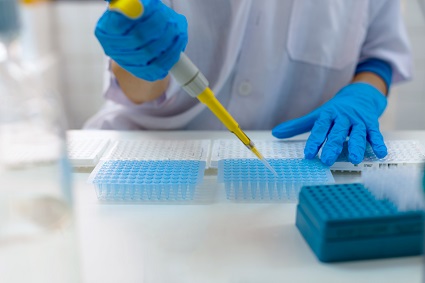Biomarker discovery in cancer research
Overview
Biomarkers, indicators of a condition or outcome, are used to indicate what is taking place within a cell at any given moment. They can be beneficial in studying basic biological processes, looking at the effects of environmental exposures, identifying molecular candidates, analyzing gene expression, as well as during the drug development process. Because there are so many kinds of biomarkers, there are many paths to their discovery. Biomarker discovery tailored for your chosen outcome supports the relevance of your biomarkers.
What is a biomarker?
A biomarker is a biological indicator of a disease or outcome. Genes, proteins, hormones, or any measurable substance can act as biomarkers for genomic, cellular, and/or proteomic analysis and interrogation. These indicators might be involved in the mechanism of disease pathogenesis, or they might be the byproduct of organism dysfunction. They can be beneficial in studying basic biological processes, looking at the effects of environmental exposures, identifying molecular candidates, and analyzing gene expression. In addition, they can be a critical component during pharmaceutical development as they can offer important insight into the safety and efficacy of the medication. There are several types of biomarkers which are often categorized into to the following types based upon how or what they measure: molecular, histologic, radiographic, or physiologic.
Biomarker discovery workflow
Molecular profiling and biomarker discovery
The search for appropriate biomarkers starts with profiling. Profiling a sample provides data about cell populations, genes, and proteins, and can be performed by a variety of methods (Table 1). Genomic (DNA), transcriptomic (RNA), and proteomic (protein) profiling have all yielded important biomarker discoveries. For example, investigation of methylation patterns can reveal methylated DNA as an epigenetic biomarker. Methylation sequencing (methyl-seq) is a next generation sequencing (NGS) technique that can be used to identify methylation patterns for early detection of several cancer types, such as colorectal cancer and esophageal adenocarcinoma [1].
Biomarker discovery can be performed during molecular profiling, as is usually the case with fluorescence-activated cell sorting (FACS), or discovery can be a separate step. Discovery involves either analyzing the data gleaned from molecular profiling to prioritize candidate biomarkers or using an additional method to further characterize the biomarkers.
Table 1. Molecular profiling.
| Type of biomarker | Method of profiling |
|---|---|
| Cell populations | FACS immunohistochemistry immunocytochemistry |
| Protein | mass spectrometry |
| RNA transcripts | qPCR NGS |
| Gene expression | PCR NGS |
Implementation
Biomarker discovery is the first step toward developing drug targets. Implementing the use of biomarkers in this way requires quality control testing of methods in a variety of different settings. Biomarkers must perform the same way in all situations. The stringency and parameters of the implementation step depend on the intended use of the biomarker.
The future of personalized genomics
Munich Leukemia Laboratory (MLL) is a leading institution for leukemia research. Watch this webinar to learn how MLL is aiming to advance hematology research with NGS, the pivotal role NGS plays in genetic profiling and personalized medicine, and how targeted panel sequencing allows for deeper investigation into genetic research questions.
Biomarkers in cancer research
Biomarkers have been particularly useful in cancer research, where they can be used to identify disease, determine prognosis, develop targeted therapies, and monitor treatment response. Early screening for cancer biomarkers can enable more effective treatment and may even be useful in the future for prevention. Several molecular tests are available to look for mutations in a variety of cancers. Novel biomarkers are being discovered at an incredible pace using a variety of different experimental techniques. One common technique, next generation sequencing (NGS), sequences known cancer-causing genes to identify genetic mutations common to different cancers. lt is important for any NGS-based discovery panel to be modular, allowing for additions and subtractions of various genetic mutations as research dictates.
Biomarker accuracy is critical when developing tests for minimal residual disease (MRD). MRD is when a small number of cancer cells remain in a person’s blood during or after treatment. MRD can lead to cancer relapse. Liquid biopsy, or blood testing, paired with NGS can identify minute numbers of cancer cells and determine whether the treatment has completely eradicated the cancer. Presence or absence of MRD identified by liquid biopsy testing can also be used to determine the effectiveness of the treatment.
One specific cancer type that has benefited from biomarker research is breast cancer. Breast cancer affects over 300,000 women each year and is the second most common cause of death from cancer for women [2]. The disease also can affect men, albeit at a much lower incidence. Although mammography is routinely used to identify cancerous lesions, some families harbor genetic mutations in the BRCA (BReast CAncer gene) genes. Every person’s genome contains the BRCA1 and BRCA2 genes, which produce proteins that repair damaged DNA. Mutations in one or both genes increase the risk of developing breast or ovarian cancer due to the loss of the repair pathway. Several molecular tests are available to look for mutations in BRCA1 and BRCA2, as well as in an increasing number of genes that have been identified as potentially harboring driver mutations for other cancers. Although these tests were traditionally done with PCR-based analysis, the decreasing cost of NGS has increased its use in identifying these mutations. In addition to the decreased cost, NGS results clearly define the type and scope of the genetic mutation(s) in a wide panel of genes.
Cancer molecular profiling
Research in the discovery and identification of new, targetable biomarkers is driven by comprehensive tumor profiling using NGS. However, converting tissue samples into NGS libraries is often challenging due to the low quantity and quality of DNA in such samples. Download this application note to explore how low-frequency variants have been identified in this application.
Applicable research technologies
Products for cancer research
Working in a research area that would benefit from sequencing? Just starting? See how you can easily improve your research workflows and results.
Explore resources
Let's connect
Uncover biomarkers with confidence.
Our NGS team is ready to answer questions to help you reach your biomarker discovery research goals. Fill out this form and one of our team members will contact you directly.
xGen NGS—made for cancer research.

Processing
References
1. Pan Y, Liu G, Zhou F, et al. DNA methylation profiles in cancer diagnosis and therapeutics. Clin Exp Med. 2018;18(1):1–14.
2. Breast Cancer: Statistics. 2022; https://www.cancer.net/cancer-types/breast-cancer/statistics, 2022.

